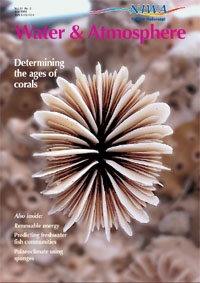PDF of this article (4 MB)

John Booth Steve Chiswell Russ Bradford Barry Bruce
The rock lobster fishery on both sides of the Tasman should benefit from specialised sampling equipment.


The New Zealand red rock lobster Jasus edwardsii has among the longest larval development known for any marine creature. The phyllosoma (Greek for leaf-like) larvae spend close to two years in oceanic waters before metamorphosing to the postlarval stage, known as the puerulus, which then swims towards the coast to settle.
Because phyllosomas are weak swimmers, they can drift large distances during their development. There is strong evidence, for example, that rock lobster larvae are transported 2000 km from southern Australia to New Zealand.
Most of our lobsters, however, probably come from locally hatched larvae held close to the shore by features such as the Wairarapa Eddy, a large permanent eddy off the southeast coast of the North Island. Once phyllosomas are in this eddy, they can remain trapped long enough to reach metamorphosis. But, because the eddy varies in position and strength, its effectiveness at retaining larvae changes from year to year.
Oceanographers use a range of satellite technologies to identify ocean currents and eddies. We can use these data to model where the phyllosomas might drift, and to look at how variations in currents and eddies might affect phyllosoma survival and dispersal. Such modelling could greatly benefit the management of the rock lobster fishery, since breeding females in some areas may be expected never to contribute to larval settlement, while those in other areas may be major sources of settlement and should therefore be carefully protected.
Vertical movements: joint venture
To model phyllosoma drift, we need to know where in the water column the larvae are located, because water movement patterns – and therefore potential drift patterns – vary with depth.
Like other plankton, phyllosomas are thought to be nearer the surface at night than during the day. They form part of the “deep-scattering layer” of animals that rises quite rapidly towards the surface to feed as dusk approaches. But how deep do the phyllosomas go during the day in avoiding predators?
Since Jasus edwardsii supports extremely important fisheries in both New Zealand and southern Australia, tracking the vertical distribution of the larvae is of interest to both countries.
To sample lobster larvae we use a very large net – 60 m long – because the larvae are quite sparse in the ocean. Even in the Wairarapa Eddy densities rarely exceed one larva per 500 m3. However, until recently we had no way of opening or closing the net at depth in order to get an idea of vertical distributions.
This was where collaboration with scientists from CSIRO, Australia’s national research organisation, came in. CSIRO has developed a device that attaches to the end of the net. It has six separate codends which we can open and close to obtain phyllosomas at specific depths (right). We used the system successfully in March 2003 from NIWA’s research vessel Tangaroa, sampling the water column to at least 300 m six times over several 24-hour periods. We also retained almost all components of the plankton, including squid, bizarre-looking fish, prawns, and salps, together forming a unique body of material for other scientists.
The results so far indicate that most mid- and late-stage phyllosoma larvae remain in the upper 50 m. There is probably only limited dispersal to greater depths during the day.
For our modelling, this result is very significant because we can now begin to use more realistic vertical behaviour in our models. Because mid and late stage make up the most of the larval developmental period, this voyage has significantly enhanced our ability to reasonably model larval movements.
John Booth and Steve Chiswell are based at NIWA in Wellington. Russ Bradford and Barry Bruce are at CSIRO, Hobart, Australia.
